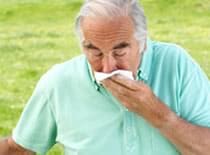How does 2009 H1N1 virus spread?
Spread of 2009 H1N1 virus is thought to occur in the same way that seasonal flu spreads. Flu viruses are spread mainly from person to person through coughing or sneezing by people with influenza. Sometimes people may become infected by touching something – such as a surface or object – with flu viruses on it and then touching their mouth or nose.
How long can an infected person spread this virus to others?
People infected with seasonal and 2009 H1N1 flu shed virus and may be able to infect others from 1 day before getting sick to 5 to 7 days after. This can be longer in some people, especially children and people with weakened immune systems and in people infected with the new H1N1 virus.
Prevention & Treatment
What can I do to protect myself from getting sick?
This season, there is a seasonal flu vaccine to protect against seasonal flu viruses and a 2009 H1N1 vaccine to protect against the 2009 H1N1 influenza virus (sometimes called "swine flu").
A flu vaccine is the first and most important step in protecting against flu infection.
For information about the 2009 H1N1 vaccines, visit H1N1 Flu Vaccination Resources. For information about seasonal influenza vaccines, visit Preventing Seasonal Flu With Vaccination.
There are also everyday actions that can help prevent the spread of germs that cause respiratory illnesses like the flu.
Take these everyday steps to protect your health:
Cover your nose and mouth with a tissue when you cough or sneeze. Throw the tissue in the trash after you use it.
- Wash your hands often with soap and water. If soap and water are not available, use an alcohol-based hand rub.*
- Avoid touching your eyes, nose or mouth. Germs spread this way.
- Try to avoid close contact with sick people.
- If you are sick with flu-like illness, CDC recommends that you stay home for at least 24 hours after your fever is gone except to get medical care or for other necessities. (Your fever should be gone without the use of a fever-reducing medicine.) Keep away from others as much as possible to keep from making others sick.
Other important actions that you can take are:
- Follow public health advice regarding school closures, avoiding crowds and other social distancing measures.
- Be prepared in case you get sick and need to stay home for a week or so; a supply of over-the-counter medicines, alcohol-based hand rubs * (for when soap and water are not available), tissues and other related items could help you to avoid the need to make trips out in public while you are sick and contagious.

Dr. Vinay Goyal is a renowned doctor who visited last week to lecture on the topic H1N1 (SWINE FLU), its origin and precautions. To summarize, Dr. Goyal reported that virus H1N1, like other Influenza A viruses, only infects the upper respiratory tract and proliferates only there. The only portals of entry are the nostrils and mouth/ throat. In a global epidemic of this nature, it's almost impossible not coming into contact with H1N1 in spite of all pre- cautions. Contact with H1N1 is not so much of a problem as proliferation is. Will a face mask protect? What most N95 respirators are designed to filter is about 95% particulates of 0.3, while the size of H1N1 virus is about 0.1. Hence, dependence on N95 to protect against H1N1 is like protecting against rain with an umbrella made of mosquito net.
Tamiflu drug does not kill the virus, but it prevents H1N1 from further prolif- eration till the virus limits itself in about 1-2 weeks during the virus’ natural cycle.
While you are still healthy and not showing any symptoms of H1N1 infection, in order to prevent proliferation, aggravation of symptoms and development of secondary infections, some very simple steps not fully highlighted in most official communications - can be practiced:
1. Frequent hand-washing.
2. "Hands-off-the-face" approach except to eat, bathe, etc.
3. Gargle twice a day with warm salt water (use Listerine if you don't trust salt). H1N1 takes 2-3 days after initial infection in the throat/ nasal cavity to pro- liferate and show characteristic symptoms. Simple gargling prevents proliferation. In a way, gargling with salt water has the same effect on a healthy individual that Tamiflu has on an infected person. Don't underestimate this simple, inexpensive and powerful preventative method.
4. Clean your nostrils at least once every day with warm salt water, swabbing both nostrils with cotton buds dipped in warm salt water is very effective in bring- ing down viral population.
5. Boost your natural immunity with foods that are rich in Vitamin C, or Vitamin C tablets that contain Zinc to boost absorption.
6. Drink as much of warm liquids as you can. Drinking warm liquids has the same effect as gargling, but in the reverse direction. They wash off proliferating viruses from the throat into the stomach where they cannot survive.

No comments:
Post a Comment